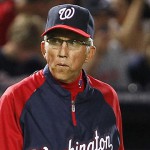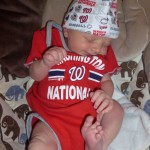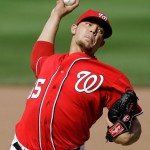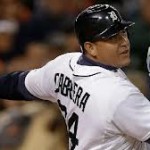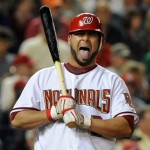
Jesus Flores achieved 5 full years of service time in 2012, complicating his roster status going forward. Photo Toni Sandys/Washington Post
In the process of opining on some preliminary Nats hot-stove moves this coming off-season, I found myself asking certain service-time/options questions about players on the 40-man roster.
So, I took the time to create a Spreadsheet of all Nats 40-man roster players with Options status for the coming season (well, actually update a version I had of this information from last year). I also tried to update everyone’s service time to what it should stand at at the end of the 2012 season (though honestly some of the service time calculations, especially for someone bounced up and down this year like Corey Brown, can be tricky).
I know that Luke Erickson‘s Nats Big Board has an “Options Status” tab, and I didn’t mean to circumvent the work there; i’m just not sure whether it has been updated for the coming season. The big board Options tab also has some helpful links to decipher some of the options ramifications, especially the tricky 4th option (which will notably come into play for several of our guys very soon, as discussed below).
Nonetheless, if I have the Options statuses and Service time calculations correctly done, there are some interesting roster management moves on the horizon. The below analysis includes a disputed 4th option for Ryan Perry; I’m pretty confident I’m correct in determining his option status but will caveat that opinion (and this whole article) by reminding the reader that I’m not in fact a professional baseball executive and may have a couple of these calculations wrong.
Here’s a full list of our current 36 40-man players (this is where we stand as of today, post FA declarations of our seven free agents plus the reverting of our former three 60-day DL guys to the 40-man roster). I’ve got these players divided into four categories, with some discussion after each:
Category 1: Vets who can refuse demotion (5 or more years of service)
Players in this category and their service time at the end of 2012:
| Name | Svc Time | First Added to 40-man | Option Years Used | # Ops Left |
| Gorzelanny, Tom | 5.16 | Sept 2005 | 2006, 2008, 2009 | 0 |
| Flores, Jesus | 5.079 | Dec 2006 | 2008, 2011 | 1 |
| Suzuki, Kurt | 5.113 | Jun 2007 | none | 3 |
| Tracy, Chad | 7.000 | Nov 2004? | ? | ? |
| Zimmerman, Ryan | 7.032 | Sep 2005 | none | 3 |
| Morse, Michael | 5.114 | Nov 2004 | 2005, 2006, 2007 | 0 |
| Werth, Jayson | 9.102 | Nov 2002? | ? | ? |
Discussion: Most of the guys on this list are no-brainer core pieces of the team in 2013 and beyond, but two names in particular raise interesting questions. First Tom Gorzelanny has now achieved enough MLB time so that he cannot be sent down without his permission, but that was largely irrelevant based on his lack of options anyway. He remains a non-tender candidate because of his expected raise from his 2012 $3M salary given his role as long-man/mop-up guy for the team (well, that is unless you’ve seen the price of left-handed relief on the FA market this off-season … maybe he’s NOT a non-tender candidate). The bigger surprise on this list is Jesus Flores, who I believe achieved his 5th full service year in 2012 and now (despite having a minor league option left) can refuse an assignment to AAA. This represents an interesting decision for the team, who clearly has Suzuki and Ramos as its #1/#2 catchers. Most think he’s also a clear non-tender candidate for 2013, but I tend to think that he’s a valuable commodity worth tendering a contract. Despite his poor batting in 2012 (slash line of .213/.248/.329) there is a market for backup catchers in this league, especially ones that once showed the hitting promise that Flores has (a slash line of .301/.371/.505 in the early part of 2009 prior to his injuries). Maybe this service time issue becomes the straw that breaks the camel’s back of his tendering decision; if we tender him, we’ll immediately have to trade him because he’ll likely refuse an assignment and be declared a free agent if he doesn’t make the 2013 team. Perhaps the team cuts bait on him before having their hand forced.
Category 2: Players with Options but who are entrenched on the 25-man roster for 2013
| Name | Svc Time | First Added to 40-man | Option Years Used | # Ops Left |
| Gonzalez, Gio | 3.162 | Aug 2008 | 2009 | 2 |
| Mattheus, Ryan | 1.111 | June 2011 | none | 3 |
| Storen, Drew | 2.140 | May 2010 | none | 3 |
| Strasburg, Stephen | 2.118 | Aug 2009 | 2010 | 2 |
| Zimmermann, Jordan | 3.154 | Apr 2009 | 2010 | 2 |
| Ramos, Wilson | 2.047 | Nov 2008 | 2009, 2010 | 1 |
| Desmond, Ian | 3.027 | Nov 2008 | 2009 | 2 |
| Espinosa, Danny | 2.033 | Sep 2010 | none | 3 |
| Lombardozzi, Steve | 1.023 | Sep 2011 | none | 3 |
| Harper, Bryce | 0.152 | Aug 2010 | 2011, 2012 | 1 |
| Moore, Tyler | 0.113 | Nov 2011 | 2012 | 2 |
Discussion; the likelihood of seeing any of these guys optioned to the minors in 2013 seems slim; mostly they are starters and key players for the team going forward. That being said, John Lannan‘s surprise demotion in 2010 while he struggled was enabled by his options availability, and a struggling player like Moore or Lombardozzi could be sent down to make room if need be.
Category 3: Players whose Options almost guaranteed to be used in 2013
| Name | Svc Time | First Added to 40-man | Option Years Used | # Ops Left |
| Kimball, Cole | 0.138 | Nov 2010 | 2011, 2012 | 1 |
| Maya, Yunesky | 0.070 | July 2010 | 2010, 2011, 2012 | 1? |
| Perry, Ryan | 2.142 | Apr 2009 | 2009, 2011, 2012 | 1? |
| Purke, Matthew | 0.000 | Aug 2011 | 2012 | 2 |
| Leon, Sandy | 0.096 | May 2012 | 2012 | 3 |
| Solano, Jhonatan | 0.092 | Nov 2011 | 2012 | 2 |
| Marrero, Chris | 0.033 | Nov 2010 | 2011, 2012 | 1 |
| Rendon, Anthony | 0.000 | Aug 2011 | 2012 | 2 |
| Perez, Eury | 0.030 | Nov 2011 | 2012 | 2 |
Discussion; This list is where some of the 4th option availability comes into play. First Yunesky Maya has already used 3 options but clearly isn’t in the plans of the team for 2013 (the final year of his 4yr/$8M wasted contract). But, if I read the options rules correctly his lack of achieving 5 professional seasons will give him a 4th option, which is likely to be used for 2013. The same goes with Ryan Perry, who was drafted in 2008 but made the Tiger’s MLB roster in 2009, nearly out of Spring Training, meaning he’s just finishing his 4th professional season. This means (as was pointed out by a reader a few posts ago) he’s eligible for a 4th option, which is likely to be used as Perry continues to remake himself as a starter. (Note: the 4th option validity for Perry has been questioned here and there and revolves around 2010, when I don’t believe he was optioned). I see him being in the AAA rotation and serving as injury insurance for the MLB rotation. Marrero and Kimball are both in the same boat; they both missed all (or most) of 2012, burning an option in the process, and unless the organization makes the decision to designate them to make room on the 40-man they will each burn their last minor league option in 2013. The rest of these players are working their way up the minor league system, or in the case of Matthew Purke, hopefully working their way back into 100% health.
Category 4: Players with Options available, jeopardizing their 25-man status in 2013
| Name | Svc Time | First Added to 40-man | Option Years Used | # Ops Left |
| Christian Garcia | 0.027 | Sep 2012 | none | 3 |
| Lannan, John | 4.045 | July 2007 | 2010, 2012 | 1 |
| Stammen, Craig | 2.160 | May 2009 | 2009, 2011 | 1 |
| Brown, Corey | 0.059 | Nov 2010 | 2011, 2012 | 1 |
Discussion: I probably should have put Stammen into the 2nd category of players, based on his breakout 2012 performance. Lannan is a likely non-tender after getting the surprising option to Syracuse in 2012 and demanding a trade; however if he’s offered arbitration he can have the same thing happen to him again in 2013, serving as a multi-millionare AAA starter/insurance policy. The question is whether or not the team wants to spend money in that fashion. It remains to be seen what the team does with Garcia; numerous reports talk of him converting to a starter. If so, his options availability would allow the team to send him to AAA to hone his craft were he to not be ready for a rotation spot out of spring training. Lastly Brown seems stuck in 4-A status right now, having cleaned up in AAA but struggled at the MLB level. Perhaps he’s also a “guarantee” to be optioned in 2013 and belonging in the 3rd category; I put him here only because the Nats outfield situation remains in so much flux. If LaRoche walks, Morse likely moves to first, Moore likely starts in left (absent another FA outfielder signing or other acquisition), Bernadina continues as the 4th outfielder and the team may possibly need a 5th outfielder candidate. Brown is a lefty though, and the team has already invested in a lefty bench bat in Chad Tracy, so perhaps this works against him. There’s so much yet to be decided though, its hard to guess how it will shake out.
Category 5: Players with no options left
| Name | Svc Time | First Added to 40-man | Option Years Used | # Ops Left |
| Clippard, Tyler | 3.148 | May 2007 | 2007, 2008, 2009 | 0 |
| Detwiler, Ross | 3.002 | Sept 2007 | 2008, 2009, 2011 | 0 |
| Rodriguez, Henry | 2.114 | Nov 2007 | 2008, 2009, 2010 | 0 |
| Rivero, Carlos | 0.000 | Nov 2009 | 2010, 2011, 2012 | 0 |
| Bernadina, Roger | 3.146 | Oct 2007 | 2008, 2009, 2011 | 0 |
Discussion: The main player that has a worry here is Carlos Rivero, claimed off waivers from Philadelphia and who burned his last option in 2012 without even getting a Sept 1 call up. He had a decent season in AAA (.303/.347/.435) but seems to be without a position (he played 3rd primarily in AAA and doesn’t seem to have another position). I’m guessing he’s DFA’d this off-season and the team attempts to re-sign him to a minor league contract. Henry Rodriguez‘s lack of options has resulted in some dubious DL-trips several times for this team, as he clearly could use some minor league time to fix his Jeckyl-and-Hyde performances. But he can’t be optioned, so in some ways the team is stuck. Honestly, I think its just a matter of time before they run out of patience and DFA him as well.
Thoughts? Corrections? Any and all feedback is welcome.

